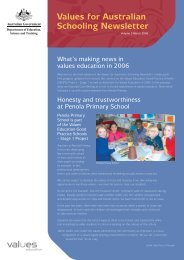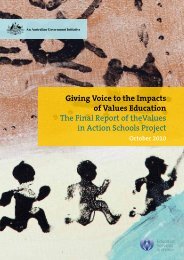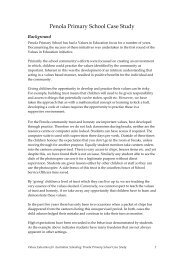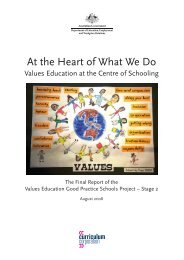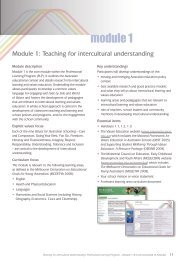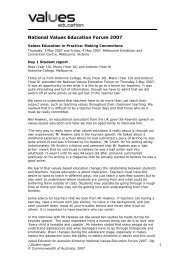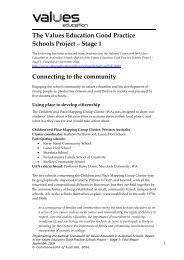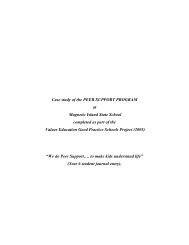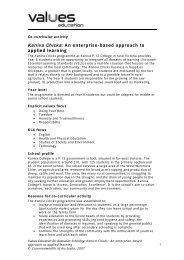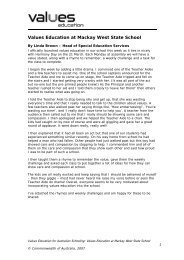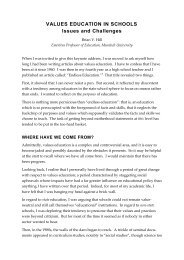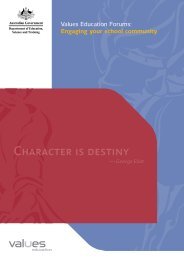Giving Voice to the Impacts of Values Education The Final Report of ...
Giving Voice to the Impacts of Values Education The Final Report of ...
Giving Voice to the Impacts of Values Education The Final Report of ...
You also want an ePaper? Increase the reach of your titles
YUMPU automatically turns print PDFs into web optimized ePapers that Google loves.
Catholic Schools <strong>of</strong> <strong>the</strong> Clarence<br />
New South Wales<br />
Resilience, Wellbeing and Learning<br />
Participating schools<br />
• St Mary’s Primary School, Bowraville<br />
• St Patrick’s Primary School, Macksville<br />
• St Mary’s Primary School, Bellingen<br />
• Mary Help <strong>of</strong> Christians Primary School, Sawtell<br />
• St Augustine’s Primary School, C<strong>of</strong>fs Harbour<br />
• St Francis Xavier Primary School, Woolgoolga<br />
• St Joseph’s Primary School, South Graf<strong>to</strong>n<br />
• St Mary’s Primary School, Graf<strong>to</strong>n<br />
• St Joseph’s Primary School, Maclean<br />
• St James’ Primary School, Yamba<br />
Cluster Coordina<strong>to</strong>r: Ms Bernadette Gilholm, St Joseph’s Primary School, Maclean<br />
Deputy Coordina<strong>to</strong>r: Ms Jennifer Triglone, St Mary’s Primary School, Bellingen<br />
University Advisor: Dr Kerry Dally, University <strong>of</strong> Newcastle<br />
<strong>The</strong> project<br />
<strong>The</strong> Catholic Schools <strong>of</strong> <strong>the</strong> Clarence cluster<br />
comprised ten primary schools on <strong>the</strong> nor<strong>the</strong>rn<br />
New South Wales coast. Although geographically<br />
dispersed over 200 kilometres, <strong>the</strong> cluster schools<br />
have a partnership relationship built around<br />
an established Diocesan structure. Promoting<br />
student resilience, wellbeing and learning are<br />
clearly articulated goals in all ten <strong>of</strong> <strong>the</strong> schools<br />
in this cluster. Many have a high proportion <strong>of</strong><br />
students in lower socioeconomic status bands<br />
and one school has a 96% enrolment <strong>of</strong><br />
Indigenous students.<br />
This project aimed <strong>to</strong> build student resilience<br />
and wellbeing, and improve academic and social<br />
outcomes, through <strong>the</strong> implicit and explicit<br />
teaching <strong>of</strong> values. This teaching incorporated a<br />
three-tiered approach addressing content, process<br />
and application, which ensured that values were<br />
embedded in school units <strong>of</strong> work, particularly<br />
in <strong>the</strong> human society and its environment<br />
learning area. In addition, <strong>the</strong> cluster schools<br />
aimed <strong>to</strong> embed cooperative and higher-order<br />
thinking strategies across all key learning areas.<br />
This included <strong>the</strong> key elements <strong>of</strong> effective<br />
learning gleaned from <strong>the</strong> Project for Enhanced<br />
Effective Learning (PEEL), (Baird & Mitchell 1997),<br />
and structured, developmentally appropriate<br />
curriculum in social and emotional learning using<br />
<strong>the</strong> Bounce Back! program model (McGrath &<br />
Noble 2003).<br />
One <strong>of</strong> <strong>the</strong> main initiatives <strong>of</strong> <strong>the</strong> cluster<br />
project was <strong>the</strong> establishment <strong>of</strong> collaborative<br />
curriculum writing teams. <strong>The</strong>se teams, drawn<br />
from each school, worked <strong>to</strong>ge<strong>the</strong>r <strong>to</strong> audit<br />
current curriculum, plan values-rich units <strong>of</strong><br />
work and participate in a residential writing<br />
Section 3: Accounts <strong>of</strong> <strong>the</strong> VASP cluster projects<br />
83



